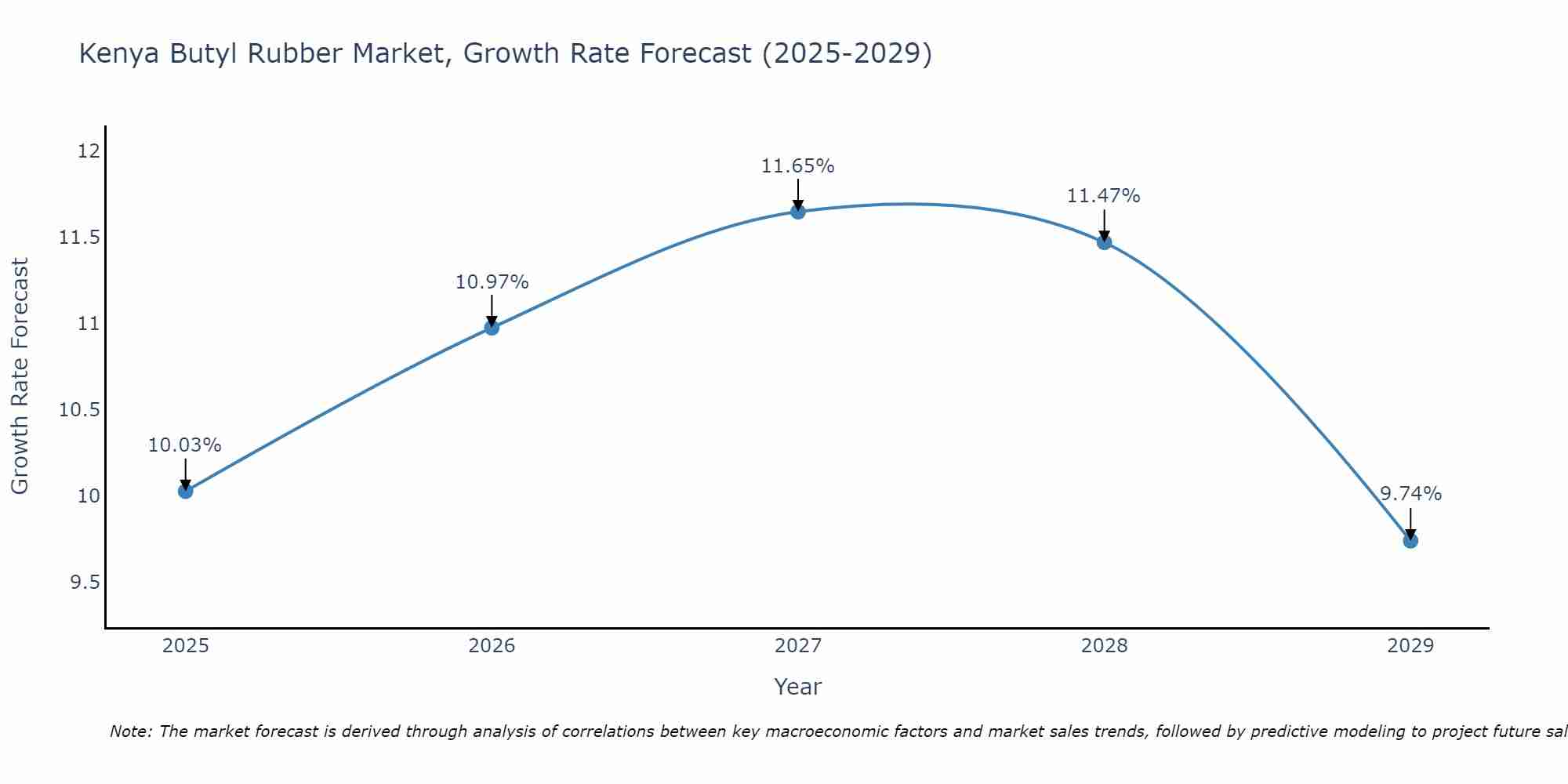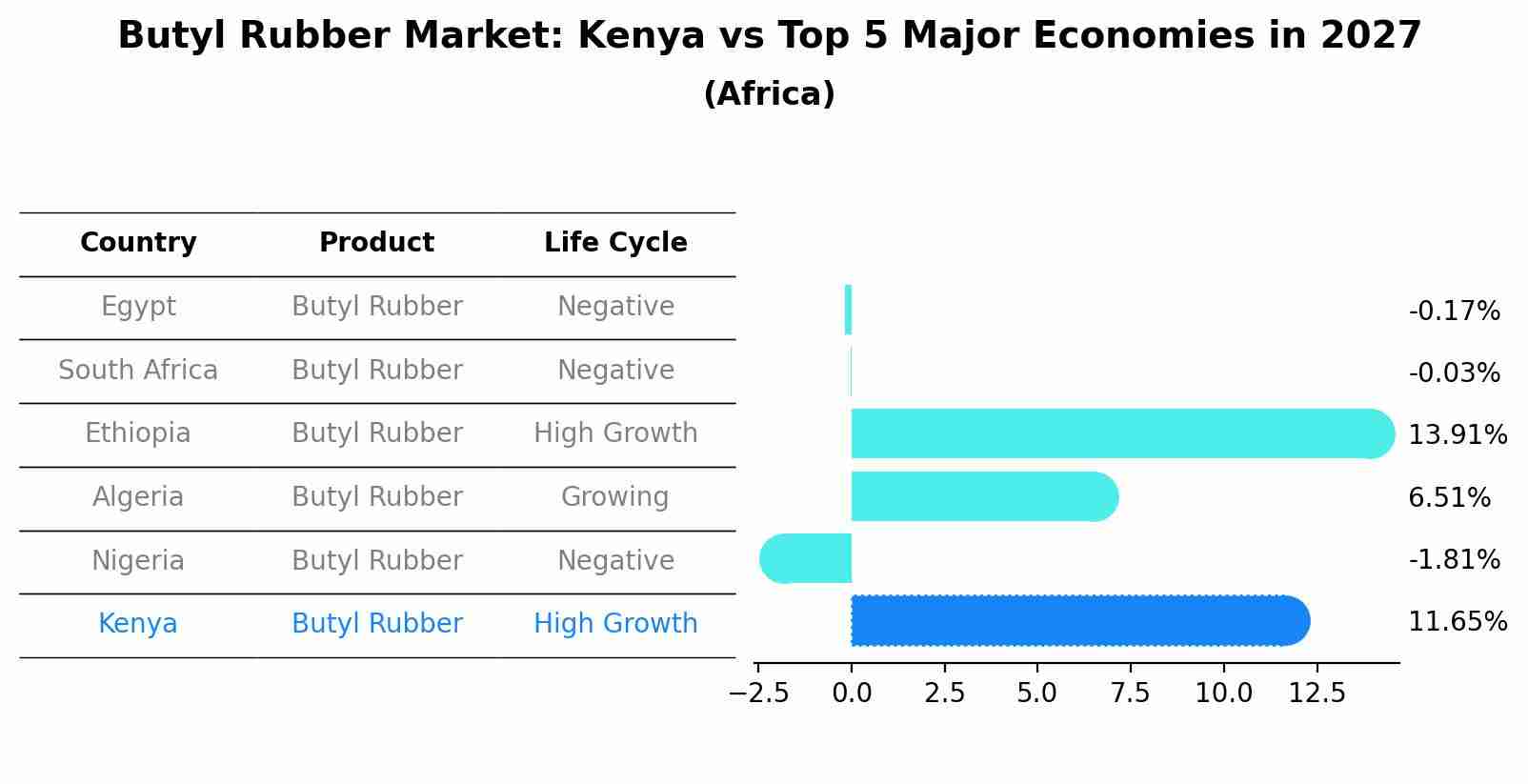Kenya Butyl Rubber Market Outlook | Revenue, Analysis, Share, Companies, Trends, Industry, Size, COVID-19 IMPACT, Forecast, Value & Growth
| Product Code: ETC316430 | Publication Date: Aug 2022 | Updated Date: Aug 2025 | Product Type: Market Research Report | |
| Publisher: 6Wresearch | No. of Pages: 75 | No. of Figures: 35 | No. of Tables: 20 | |
Kenya Butyl Rubber Market Size Growth Rate
The Kenya Butyl Rubber Market is projected to witness mixed growth rate patterns during 2025 to 2029. Growth accelerates to 11.65% in 2027, following an initial rate of 10.03%, before easing to 9.74% at the end of the period.

Butyl Rubber Market: Kenya vs Top 5 Major Economies in 2027 (Africa)
The Butyl Rubber market in Kenya is projected to grow at a high growth rate of 11.65% by 2027, highlighting the country's increasing focus on advanced technologies within the Africa region, where Egypt holds the dominant position, followed closely by South Africa, Ethiopia, Algeria and Nigeria, shaping overall regional demand.

Kenya Butyl Rubber Market Overview
The butyl rubber market in Kenya is expanding, driven by demand from the automotive and construction industries. Government policies supporting industrialization and infrastructure development are key factors promoting market growth. The market is also benefiting from investments in manufacturing capabilities and the adoption of advanced rubber processing technologies.
Drivers of the market
The Kenya butyl rubber market is driven primarily by the growing demand in the automotive sector, particularly for tire manufacturing due to butyl rubbers excellent impermeability to gases and resistance to weathering. Additionally, the increasing infrastructure projects in Kenya spur demand for construction materials, including butyl rubber for sealants and adhesives. Rising disposable incomes and urbanization are also contributing to the expanding automotive and construction industries, thereby boosting the butyl rubber market.
Challenges of the market
The butyl rubber market in Kenya encounters challenges such as high production costs and competition from synthetic alternatives. Butyl rubber production requires advanced technology and high-quality raw materials, leading to significant costs. Additionally, the market faces competition from other synthetic rubbers and elastomers, which can offer similar properties at lower costs.
Government Policy of the market
Recognizing the importance of rubber industry development in supporting manufacturing and infrastructure sectors, the Kenya government has implemented policies to regulate the butyl rubber market. These policies include quality standards for butyl rubber production, support for research and development in rubber technology, and investment incentives for rubber processing facilities to promote value addition and export competitiveness.
Key Highlights of the Report:
- Kenya Butyl Rubber Market Outlook
- Market Size of Kenya Butyl Rubber Market, 2021
- Forecast of Kenya Butyl Rubber Market, 2028
- Historical Data and Forecast of Kenya Butyl Rubber Revenues & Volume for the Period 2018 - 2028
- Kenya Butyl Rubber Market Trend Evolution
- Kenya Butyl Rubber Market Drivers and Challenges
- Kenya Butyl Rubber Price Trends
- Kenya Butyl Rubber Porter's Five Forces
- Kenya Butyl Rubber Industry Life Cycle
- Historical Data and Forecast of Kenya Butyl Rubber Market Revenues & Volume By Product Type for the Period 2018 - 2028
- Historical Data and Forecast of Kenya Butyl Rubber Market Revenues & Volume By Regular Butyl Rubber for the Period 2018 - 2028
- Historical Data and Forecast of Kenya Butyl Rubber Market Revenues & Volume By Halo Butyl Rubber for the Period 2018 - 2028
- Historical Data and Forecast of Kenya Butyl Rubber Market Revenues & Volume By Bromo-Butyl Rubber for the Period 2018 - 2028
- Historical Data and Forecast of Kenya Butyl Rubber Market Revenues & Volume By Chloro-Butyl Rubber for the Period 2018 - 2028
- Historical Data and Forecast of Kenya Butyl Rubber Market Revenues & Volume By Application for the Period 2018 - 2028
- Historical Data and Forecast of Kenya Butyl Rubber Market Revenues & Volume By Tires & Tubes for the Period 2018 - 2028
- Historical Data and Forecast of Kenya Butyl Rubber Market Revenues & Volume By Pharmaceuticals for the Period 2018 - 2028
- Historical Data and Forecast of Kenya Butyl Rubber Market Revenues & Volume By Adhesives & Sealants for the Period 2018 - 2028
- Historical Data and Forecast of Kenya Butyl Rubber Market Revenues & Volume By Automotive for the Period 2018 - 2028
- Historical Data and Forecast of Kenya Butyl Rubber Market Revenues & Volume By Others for the Period 2018 - 2028
- Kenya Butyl Rubber Import Export Trade Statistics
- Market Opportunity Assessment By Product Type
- Market Opportunity Assessment By Application
- Kenya Butyl Rubber Top Companies Market Share
- Kenya Butyl Rubber Competitive Benchmarking By Technical and Operational Parameters
- Kenya Butyl Rubber Company Profiles
- Kenya Butyl Rubber Key Strategic Recommendations
Frequently Asked Questions About the Market Study (FAQs):
1 Executive Summary |
2 Introduction |
2.1 Key Highlights of the Report |
2.2 Report Description |
2.3 Market Scope & Segmentation |
2.4 Research Methodology |
2.5 Assumptions |
3 Kenya Butyl Rubber Market Overview |
3.1 Kenya Country Macro Economic Indicators |
3.2 Kenya Butyl Rubber Market Revenues & Volume, 2021 & 2028F |
3.3 Kenya Butyl Rubber Market - Industry Life Cycle |
3.4 Kenya Butyl Rubber Market - Porter's Five Forces |
3.5 Kenya Butyl Rubber Market Revenues & Volume Share, By Product Type, 2021 & 2028F |
3.6 Kenya Butyl Rubber Market Revenues & Volume Share, By Application, 2021 & 2028F |
4 Kenya Butyl Rubber Market Dynamics |
4.1 Impact Analysis |
4.2 Market Drivers |
4.2.1 Increasing demand for butyl rubber in the automotive industry for tire manufacturing |
4.2.2 Growth in the construction sector leading to higher demand for butyl rubber-based sealants and adhesives |
4.2.3 Rising focus on sustainable and eco-friendly materials driving the adoption of butyl rubber in various applications |
4.3 Market Restraints |
4.3.1 Fluctuating raw material prices impacting the production cost of butyl rubber |
4.3.2 Competition from alternative materials like natural rubber and synthetic rubber |
4.3.3 Regulatory challenges related to environmental concerns and waste management of butyl rubber products |
5 Kenya Butyl Rubber Market Trends |
6 Kenya Butyl Rubber Market, By Types |
6.1 Kenya Butyl Rubber Market, By Product Type |
6.1.1 Overview and Analysis |
6.1.2 Kenya Butyl Rubber Market Revenues & Volume, By Product Type, 2018 - 2028F |
6.1.3 Kenya Butyl Rubber Market Revenues & Volume, By Regular Butyl Rubber, 2018 - 2028F |
6.1.4 Kenya Butyl Rubber Market Revenues & Volume, By Halo Butyl Rubber, 2018 - 2028F |
6.1.5 Kenya Butyl Rubber Market Revenues & Volume, By Bromo-Butyl Rubber, 2018 - 2028F |
6.1.6 Kenya Butyl Rubber Market Revenues & Volume, By Chloro-Butyl Rubber, 2018 - 2028F |
6.2 Kenya Butyl Rubber Market, By Application |
6.2.1 Overview and Analysis |
6.2.2 Kenya Butyl Rubber Market Revenues & Volume, By Tires & Tubes, 2018 - 2028F |
6.2.3 Kenya Butyl Rubber Market Revenues & Volume, By Pharmaceuticals, 2018 - 2028F |
6.2.4 Kenya Butyl Rubber Market Revenues & Volume, By Adhesives & Sealants, 2018 - 2028F |
6.2.5 Kenya Butyl Rubber Market Revenues & Volume, By Automotive, 2018 - 2028F |
6.2.6 Kenya Butyl Rubber Market Revenues & Volume, By Others, 2018 - 2028F |
7 Kenya Butyl Rubber Market Import-Export Trade Statistics |
7.1 Kenya Butyl Rubber Market Export to Major Countries |
7.2 Kenya Butyl Rubber Market Imports from Major Countries |
8 Kenya Butyl Rubber Market Key Performance Indicators |
8.1 Percentage of butyl rubber usage in the automotive sector compared to other rubber types |
8.2 Number of construction projects utilizing butyl rubber-based sealants and adhesives |
8.3 Adoption rate of butyl rubber in new applications and industries |
9 Kenya Butyl Rubber Market - Opportunity Assessment |
9.1 Kenya Butyl Rubber Market Opportunity Assessment, By Product Type, 2021 & 2028F |
9.2 Kenya Butyl Rubber Market Opportunity Assessment, By Application, 2021 & 2028F |
10 Kenya Butyl Rubber Market - Competitive Landscape |
10.1 Kenya Butyl Rubber Market Revenue Share, By Companies, 2021 |
10.2 Kenya Butyl Rubber Market Competitive Benchmarking, By Operating and Technical Parameters |
11 Company Profiles |
12 Recommendations |
13 Disclaimer |
- Single User License$ 1,995
- Department License$ 2,400
- Site License$ 3,120
- Global License$ 3,795
Search
Related Reports
- ASEAN and Thailand Brain Health Supplements Market (2025-2031) | Strategy, Consumer Insights, Analysis, Investment Trends, Opportunities, Growth, Size, Share, Industry, Revenue, Segments, Value, Segmentation, Supply, Forecast, Restraints, Outlook, Competition, Drivers, Trends, Demand, Pricing Analysis, Competitive, Strategic Insights, Companies, Challenges
- ASEAN Bearings Market (2025-2031) | Strategy, Consumer Insights, Analysis, Investment Trends, Opportunities, Growth, Size, Share, Industry, Revenue, Segments, Value, Segmentation, Supply, Forecast, Restraints, Outlook, Competition, Drivers, Trends, Demand, Pricing Analysis, Competitive, Strategic Insights, Companies, Challenges
- Europe Flooring Market (2025-2031) | Outlook, Share, Industry, Trends, Forecast, Companies, Revenue, Size, Analysis, Growth & Value
- Saudi Arabia Manlift Market (2025-2031) | Outlook, Size, Growth, Trends, Companies, Industry, Revenue, Value, Share, Forecast & Analysis
- Uganda Excavator, Crane, and Wheel Loaders Market (2025-2031) | Strategy, Consumer Insights, Analysis, Investment Trends, Opportunities, Growth, Size, Share, Industry, Revenue, Segments, Value, Segmentation, Supply, Forecast, Restraints, Outlook, Competition, Drivers, Trends, Demand, Pricing Analysis, Competitive, Strategic Insights, Companies, Challenges
- Rwanda Excavator, Crane, and Wheel Loaders Market (2025-2031) | Strategy, Consumer Insights, Analysis, Investment Trends, Opportunities, Growth, Size, Share, Industry, Revenue, Segments, Value, Segmentation, Supply, Forecast, Restraints, Outlook, Competition, Drivers, Trends, Demand, Pricing Analysis, Competitive, Strategic Insights, Companies, Challenges
- Kenya Excavator, Crane, and Wheel Loaders Market (2025-2031) | Strategy, Consumer Insights, Analysis, Investment Trends, Opportunities, Growth, Size, Share, Industry, Revenue, Segments, Value, Segmentation, Supply, Forecast, Restraints, Outlook, Competition, Drivers, Trends, Demand, Pricing Analysis, Competitive, Strategic Insights, Companies, Challenges
- Angola Excavator, Crane, and Wheel Loaders Market (2025-2031) | Strategy, Consumer Insights, Analysis, Investment Trends, Opportunities, Growth, Size, Share, Industry, Revenue, Segments, Value, Segmentation, Supply, Forecast, Restraints, Outlook, Competition, Drivers, Trends, Demand, Pricing Analysis, Competitive, Strategic Insights, Companies, Challenges
- Israel Intelligent Transport System Market (2025-2031) | Strategy, Consumer Insights, Analysis, Investment Trends, Opportunities, Growth, Size, Share, Industry, Revenue, Segments, Value, Segmentation, Supply, Forecast, Restraints, Outlook, Competition, Drivers, Trends, Demand, Pricing Analysis, Competitive, Strategic Insights, Companies, Challenges
- Uganda Precast and Aggregate Market (2025-2031) | Strategy, Consumer Insights, Analysis, Investment Trends, Opportunities, Growth, Size, Share, Industry, Revenue, Segments, Value, Segmentation, Supply, Forecast, Restraints, Outlook, Competition, Drivers, Trends, Demand, Pricing Analysis, Competitive, Strategic Insights, Companies, Challenges
Industry Events and Analyst Meet
Our Clients
Whitepaper
- Middle East & Africa Commercial Security Market Click here to view more.
- Middle East & Africa Fire Safety Systems & Equipment Market Click here to view more.
- GCC Drone Market Click here to view more.
- Middle East Lighting Fixture Market Click here to view more.
- GCC Physical & Perimeter Security Market Click here to view more.
6WResearch In News
- Doha a strategic location for EV manufacturing hub: IPA Qatar
- Demand for luxury TVs surging in the GCC, says Samsung
- Empowering Growth: The Thriving Journey of Bangladesh’s Cable Industry
- Demand for luxury TVs surging in the GCC, says Samsung
- Video call with a traditional healer? Once unthinkable, it’s now common in South Africa
- Intelligent Buildings To Smooth GCC’s Path To Net Zero













